|
Posted: 3/13/2017 8:26:36 PM EDT
I thought this post was lost when the Bushmaster Industry forum was removed years ago, but somehow I stumbled across it today. Figured I'd repost for anyone that may be looking into the ACR now that it's starting to make a comeback.
Original 2011 post: http://www.ar15.com/forums/t_2_28/205931_Bushmaster_ACR_Review___SIXTH_RANGE_TRIP___8_17_11.html Background I was one of those guys that started saving money once the Magpul Masada was first announced at SHOT 2007. I read every magazine article, found every picture, and scoured every SHOT video and interview on the new rifle since it was the first rifle in a string of releases of non-AR15 semi automatic rifles that actually impressed me. The Masada was the first rifle to incorporate enough extra features to successfully draw my attention away from the AR15. 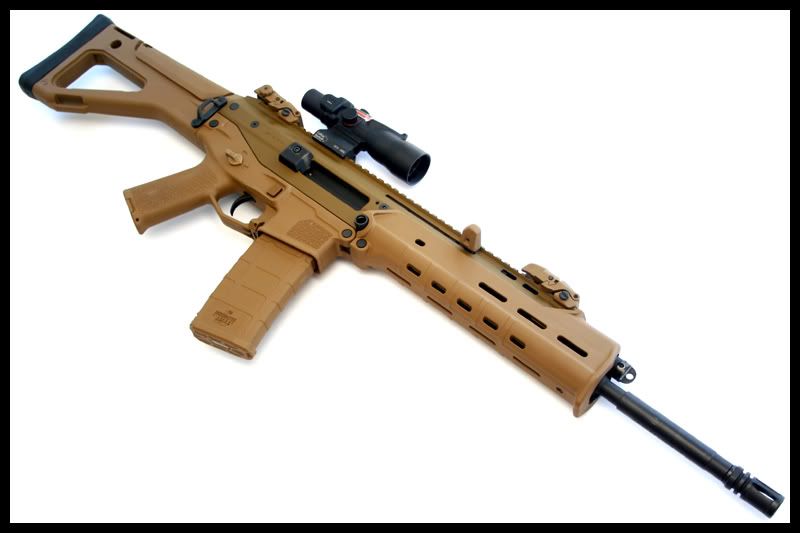
Bushmaster ACR Basic comes standard with polymer handguard, fixed stock, and Magpul Backup Iron Sights. ACOG TA33 is attached using a Larue Tactical Mini-ACOG mount. I started saving up my pennies and waited for the Masada's release. And waited. And waited. And waited some more. I became extremely nervous when the Masada design was licensed to Bushmaster. I've owned Bushmaster rifles, have a lot of experience trying to diagnose coworker's problems with theirs, and know Bushmaster's sketchy reputation with their AR15 platform—specifically the lack of QC conducted during production. I also recognized Bushmaster's lack of ingenuity when it came designing their own rifles and AR15 variants that were not a direct copy of production Colts. However, I did trust Magpul and hoped that they retained enough oversight to keep Bushmaster from screwing up the Masada. I was eagerly awaiting the January 2010 ACR release with cash in hand. However, the initial price was so outrageous that it only took about 10 seconds to become completely disillusioned with a rifle that I had been waiting 3 years for. I cursed Bushmaster for destroying the only non-AR15 rifle that had caught my interested, washed my hands of the rifle (and company), and secret hoped the ACR would be a spectacular failure just to spite the company that destroyed the Masada. Once my anger finally subsided a bit, I kept tabs on the ACR's development out of curiosity. I observed Bushmaster's reaction and kept track of the user AARs. I discovered that, despite the botched release and questionable Bushmaster decision making, I still really liked the concept and features of the production ACR. Finally, a year and half after its release when Jetguns offered the ACR Basic for $1600, I decided to acquire the rifle I had waited four and half years for. First Impressions I went with the Basic model because I prefer the plastic fore end to the rails. The plastic fore end is longer, more comfortable, still free floats, and felt lighter side by side with the Enhanced. I also really liked the fixed ACR stock—it's the exact same length that I normally adjust all of my AR stocks. When comparing the Basic and Enhanced side by side in a local gun store, the Enhanced indeed felt a bit front heavy like the online reviews suggest, but the Basic balances much better near the front of the mag well. In the store, the Basic did not feel heavy at all. As nice as the 6lbs ARs are to carry around, I actually prefer the shooting characteristics of rifles in the 7 to 8lbs range. The ACR Basic felt good. 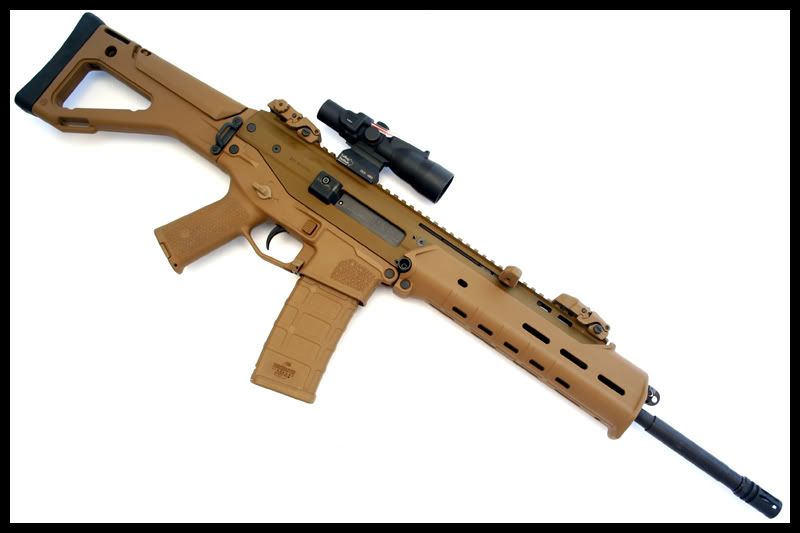
The plastic handguard provides an extra couple inches of grip toward the muzzle end over the shorter railed handguard. Those few inches can make a drastic difference in recoil control using a far forward support hand grip. The closest AR configuration to the ACR Basic that I own is a Daniel Defense with 16” M4 profile barrel, 12” rails, CTR stock, and iron sights only. The rifle has perfect weight and balance for me. I discovered that both the DD and ACR had the exact same balance point just in front of the mag well. However, the ACR was indeed a tad on the heavy side at 8lbs 5oz compared to the DD's 7lbs 4oz on my digital fish scale. All that said, I'm not sure how people expected any piston rifle to be lighter than an AR. The whole point of the AR's direct impingement system was to save weight, so I don't know why anyone expected to save more weight by going back to a piston. The SCAR cut weight by using a lightweight barrel, but the same could easily by done to the ACR or for that matter to the AR to make it even lighter. That brings me to the barrel profile: it's retarded. There is absolutely no reason to use an M4 profile barrel on the ACR. The fact that Bushmaster engineers sat around shooting all sorts of barrel profiles and decided that the M4 was best proves they they don't know what they are talking about. Not only is the useless M203 cutout an eye sore, but shifting the barrel mass away from under the handguards toward the muzzle puts that mass where it is most useless and single-handedly causes the front heavy feeling that users complain about. There's just no reason for it, and it reeks of ignorance. The 1/9 barrel twist is another puzzling feature. The 1/7 twist has become the industry standard for serious rifles due the guaranteed stabilization of heavier OTM bullets that offer increased accuracy and wound potential. Also, for a rifle with ambitions of military service, the inability to stabilized the issued tracer bullet is a deal breaker. While the 1/9 twist will probably work fine for most civilian users, there's absolutely no reason to not go with the 1/7 that will definitely work for all users. The fact that Bushmaster designers by their own admission do not believe that anyone wants a 1/7 barrel further illuminates their ignorance. Bushmaster forwent chrome lining the barrel and chamber in favor of Meloniting the inside and outside of the barrel as well as the action components. This should allow a more accurate barrel since it offers the corrosion resistance of chrome lining with the uniformity of unlined barrels. If the Melonite proves to be as corrosion and wear resistant as Glock's similar Tennifer treatment, then I look forward to taking advantage of it, especially with the self lubricity that Bushmaster claims. If the Melonite lives up to its promises, then it definitely looks like a step in the right direction. As a left handed rifle shooter, the ACR's ambidexterity was a huge selling point. I love the ambidextrous safety, magazine release, and bold release, but I am unsure why they stopped there. The front QD sling attachment point is ambi, but the rear is not. While swappable, it seems like a no-brainer to go fully ambi from the get go. Also, the same can be said about the single point sling attachment—while it's also swappable, the design easily lends itself to a simple fully ambi conversion. Seems one could take a second single point sling attachment, bore out the threads, use two screws that are just a bit longer, and voila: fully ambi single point sling attachments. I went ahead and swapped the single point sling attachment to the right side of the rifle. I left the rear QD cup in place since I prefer attaching the rear end of two point slings to the outer side of the rifle. Similarly, the charging handle is also swappable instead of ambi. While swapping the charging handle to the right side works well for me, it will not work well for everyone else that I hand my rifle to. While configurable for left handed shooters, it is at the expense of right handed shooters that may use the same rifle. I use zero left handed/ambidextrous controls on my AR15s because I want to be able to successfully operate any AR I pick up. I wish that I did not have to worry about the same thing on a rifle that claims to be ambidextrous. 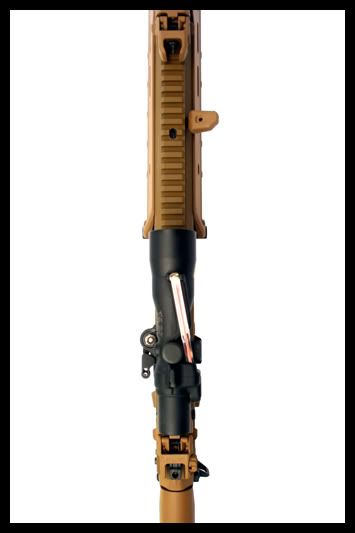
The ACR's controls are mostly ambidextrous. However, the charging handle and single point sling loop were swapped to the right side of the rifle for left handed compatibility. However, I do like the charging hand location. It does not reciprocate and the location makes it quick to operate. On the right side of the rifle, it does not obscure the visibility of the ejection port for left handed shooters like it would if it were directly above it. The forward location is also out of the way of optics. Some have criticized this location due to forward mounted IR lasers obscuring the charging handle, but if my choices are being obscured by optics versus being obscured by an IR laser, then I believe Bushmaster made the right decision due to the number of rifles equipped with optics versus the number equipped with IR lasers. 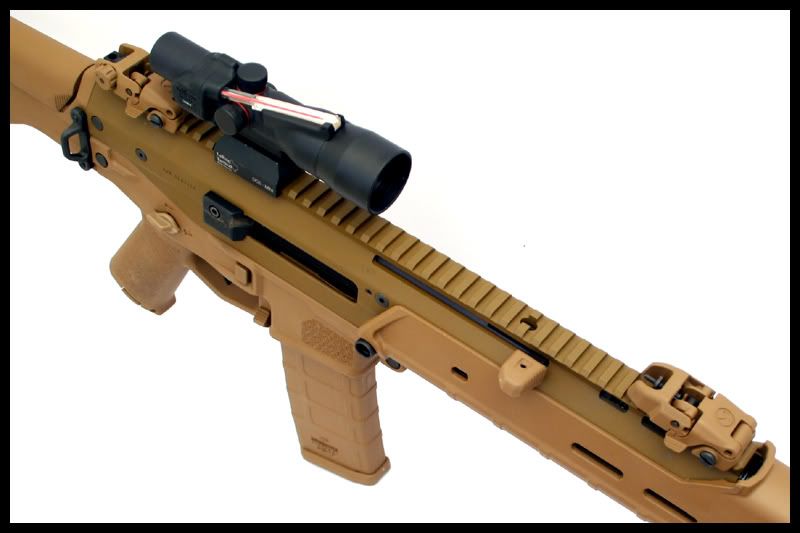
The forward charging handle position was completely out of the way of mounted optics. However, optics compatibility may be at the expense of IR laser compatibility for some users. The ACR attributes its modularity to the quick change stock, fore end, and barrel. The stock and fore end are absolutely ingenious; while both are rock solid, they can each be swapped simply by pushing a single pin. As someone who has changed a lot of AR stocks and fore ends of the years, the ACR was gleefully beautiful in this regard. As I mentioned earlier, the stock was the perfect length and had a nice thick rubber contact pad. The adjustable cheek comb worked well with the included Magpul iron sights in the low position, and I could see the high position being more comfortable with higher mounted optics. I really liked the feel of the Basic fore end—especially the length since I prefer a far forward hold with my support hand. The longer Basic fore end was much more comfortable than the shorter railed fore end of the Enhanced. I am not sure why Bushmaster went with a shorter rail on the Enhanced instead of sticking with the original Basic fore end length. 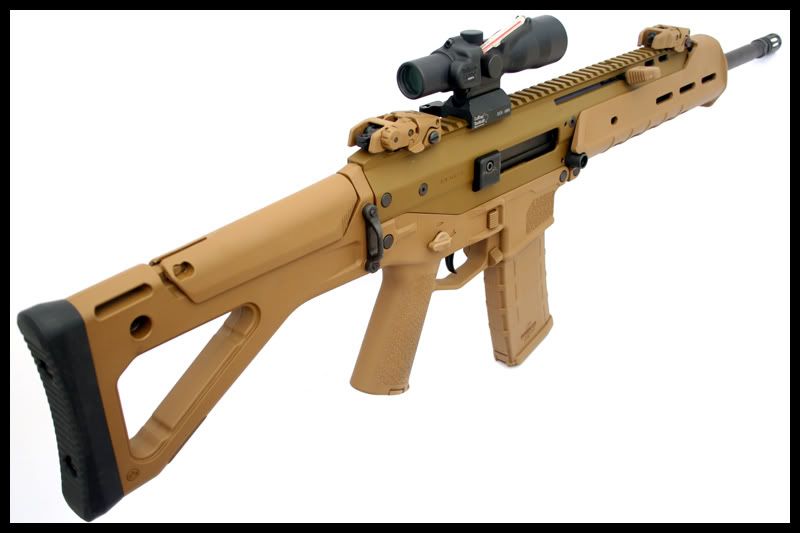
The fixed stock length felt perfect. Only the bottom pin in front of the single point sling loop needs to be popped out to replace with the folding stock. The quick change barrel was neat. However, I believe that tool less quick change barrels are highly overrated on semi automatic rifles. 30 second barrel swaps to different barrel lengths or even different calibers are meaningless when it still takes a a 30 minute range trip to rezero the sights. The ACR's wire ratchet doesn't appear to weigh much, so I don't really see any downside unless it affects accuracy. I have heard complaints about the integral polymer pistol grip. However, I like the grip, and it offers superior strength to a removable one. The standard Magpul texture works well, and the included CR123 battery core is a nice touch. Speaking of polymer, the selector, magazine release, and bolt release are all polymer. Since they wear against metal surfaces, I would prefer to see a metal selector and magazine release. The bolt release has a polymer grip surface attached to an actual metal bolt release, so I do not see any problems there. The bolt release was easily manipulated on an empty magazine and with no magazine. The bolt hold open manipulation offered by the ACR's bolt release solves a huge AR weapon manipulation for right handed shooters. I also noticed that both sides of the mag well interior have cutouts that allow any debris caught around the action to fall around the outside of the magazine and out of the rifle. First Range Trip The first outing with the ACR was brief. I did not have much time and only had access to a 25 yard range. Mostly, I just wanted to make sure I did not got a factory lemon that would give me problems from the get go. In an effort to test the Melonite's self lubricity, I did not clean, oil, or perform any other preventive maintenance on the ACR before shooting, and I plan on leaving it dry and dirty until failure. I zeroed the small aperture on the MBUS at 25 yards then switched to the large aperture for some familiarization fire and ammunition function testing at 10 yards. I only had time to shoot 100 rounds consisting of 20 rounds of lacquer coated Hornady Training .223, 40 rounds of polymer coated Wolf, 20 rounds of brass Winchester Q3131A 5.56mm, and 20 rounds of brass Speer .223. I did not have any malfunctions with any ammunition. I quickly noticed the mechanical sight off set at 10 yards. Rounds were impacting over 3” low compared to the 2.5” off set of the AR. They were so low that I shot an additional group at 25 yards to confirm that the sights were not loose (they weren't). I later measured the height over bore of the irons with a dial caliper at 3.15” which is a half inch higher than irons on an AR. I adjusted my POI and continued. A trick I use with iron sights on the AR at close range is to look over the rear sight and line the tip of the front sight with the top of the rear aperture. This carried over successfully to the ACR despite the height over bore difference. 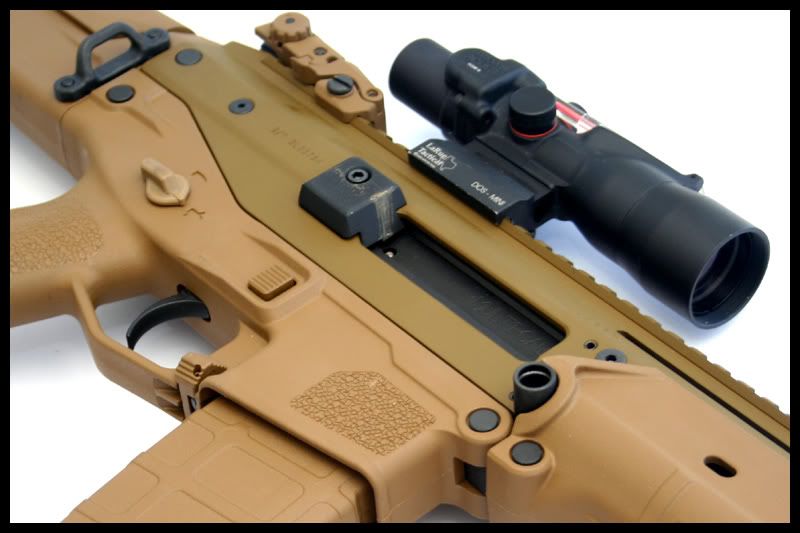
The ACR's height of over is .5" taller than the AR. However, the ACOG TA33 bullet drop compensator was dead on at 250 and 500 yards using 75gr ammunition. The recoil on the ACR was different. Some have characterized it as more than the AR, but I'm not prepared to make any conclusion yet. It does it indeed feel different though—no doubt due to the piston system's heavier reciprocating mass and heavier recoil springs. Muzzle rise did not seems excessive, but it seemed a bit more erratic than the AR—the muzzle seemed to jump side to side more during recoil. That said, controlled pairs and triplets were effortlessly kept inside the 6” circle at 10 yards. I plan on breaking out the shot timer doing a much more exhaustive comparison on my next range trip before making any conclusions. My only complaint during this range trip is the heat buildup at the front of the handguard. Since I prefer a far forward support hand grip for maximum muzzle control, my support hand grips the fore end in front of the front sight with my thumb over the top and my index finger actually on the front side of the fore end. Unfortunately, the places my hand directly around the piston where all of the heat collects. A couple magazines of ammunition at a fairly quick rate of fire conducting one up drills, controlled pairs and triplets, and multiple target engagements left the front of the handguard quite uncomfortable to grip. Not impossible, just not comfortable—my hand did not actually burn. Moving my hand midway back on the fore end completely alleviated the issue, so shooters who do not shoot with their support arm fully extended should not have any problem. I also found that the bolt release was much more difficult to manipulate when closing the bolt on a full magazine. Several times I resorted to hitting it with my support hand thumb which was easy every time. I've heard that the bolt release gets easier with use. We'll see. The magazine had a bit more play inside the mag well than I'm used to with AR15s. I tried firing a few rounds will pressing down, down and forward, and down and rearward on the magazine and did not have any problems. More testing on that is planned. Future range testing planned: higher round count, head to head comparison against a comparable AR, silhouette engagement out to 500 yards. <hr style="width: 100%; height: 2px;" /> **UPDATE** 7-1-11 Second Range Trip – Close range comparison of AR15 vs ACR I had a rifle bay all to myself for my second range trip, so I had much more freedom to evaluate the ACR during some close range drills. The close range evaluation comprised of three Viking Tactics drills plus a Bill Drill and a par time drill, and I performed each drill three to five times with each rifle recording each drills' total time, average split time, average target transition time, and reload time when applicable. I video recorded the last relay of each drill—sometimes the relay videoed was the fastest, and sometimes it wasn't. Unless otherwise noted, all hits were center A zone on a standard IPSC target. Again, the comparison AR15 was a Daniel Defense M4 which is the AR15 most similar to the ACR that I own. It has iron sights, 16” M4 profile barrel, 12” free floating rails, Magpul CTR stock, and A2 flash hider. 2x2x2 Drill – Two rounds each at three targets at 5 yards. DDM4 – Average total time: 2.38 sec; Average split time: .18 sec; Average target transition: .62 sec ACR – Average total time: 2.54 sec; Average split time: .20 sec; Average target transition: .62 sec http://www.youtube.com/watch?v=ODrKL8o92Z8 El Prez Drill – Two rounds each at three targets, emergency reload, two rounds each at three targets at 10 yards. DDM4 – Average total time: 10.26 sec; Average split time: .26 sec; Average target transition: .74 sec; reload: 4.78 sec ACR – Average total time: 9.33 sec; Average split time: .22 sec; Average target transition: .75 sec; reload: 4.12 sec http://www.youtube.com/watch?v=wduBTBCPxdk Triple Threat Drill – Three rounds chest, one round pelvis, one round head each on three targets at 5 yards. DDM4 – Average total time: 7.21 sec ACR – Average total time: 6.85 sec http://www.youtube.com/watch?v=saYmtUWBMO4 Bill Drill – Six rounds on one target at 10 yards. DDM4 – Average total time: 2.13 sec; Average split time: .29 sec ACR – Average total time: 1.86 sec; Average split time: .22 sec http://www.youtube.com/watch?v=xtZyUVertPU Par Time Drill – Maximum number of A zone hits in 2 seconds from 7 yards. DDM4 – 8 rounds (1.75 seconds used) ACR – 10 rounds (1.95 seconds used) Note: The split times during the DDM4 run would have allowed one additional shot before the par time expired, but my sights had drifted out of the A zone so I did not break the shot. However, 8 A zone hits is about my average with this rifle. The Par Time Drill was the only test performed with only one relay. http://www.youtube.com/watch?v=8iKKX_Fc-QE Compilation video of all test: http://www.youtube.com/watch?v=_TqSEoVne1E I noted after my first range trip how different the ACR's recoil felt compared to the AR, and the above drills allowed my to evaluate it much further. First, the ACR unequivocally does NOT have more recoil than the AR in my opinion. However, probably due to the larger interior reciprocating mass, the shooter does feel more going on during the ACR's recoil impulse. The ACR actually had a much less mild rearward impulse, or kick, against my shoulder compared to the AR, and it also has considerably less muzzle rise. The tradeoff, however, was that instead of a muzzle rise, the ACR exhibited more of a side to side muzzle shake. My guess is that the shake is induced first by the bolt carrier bouncing off the buffer at the front of the stock after extraction then slamming back forward after chambering the next round. The effect of the AR's muzzle rise versus the ACR's muzzle shake is apparent in the average split times of the above drills. Firing only two rounds at closer ranges (2x2x2 drill) was quicker with the AR due to the relatively tall A zone on the standard IPSC target since I do not have to wait for the muzzle to recover during muzzle rise before breaking my second shot and still attain an A zone hit. However, as the distance or number of rounds in succession grew larger, the AR's muzzle rise had more of an effect since I had to wait a bit longer for the muzzle to recover—firing before complete recovery would throw shots higher above the A zone. While that second shot may have still been an A zone hit at close range, the 3rd, 4th, etc may not have been without allowing the muzzle to recover. Conversely, the ACR's side to side muzzle shake kept moving steadily back and forth with additional rounds and did not continuously jump one direction or another. This meant that additional shots did not result in addition muzzle drift due to recoil. Throughout today's range trip, I was becoming more accustomed to the ACR's recoil and became better as controlling the muzzle shake. I believe that with more practice, it can be greatly minimized resulting an overall better muzzle control compared to a non-braked AR. This muzzle control manifests itself during the Par Time Drill which is a drill I use to evaluate my grip and stance as well as measure the effectiveness of recoil reduction devices like muzzle brakes. The drill is simply testing how many rounds I can put into the A zone from 7 yards in 2 seconds. As shown during today's test, 8 rounds is about average using a good stance and no muzzle brake. My personal best is 10 rounds using a 16” midlength AR with PWS FSC556 muzzle brake. However, my first attempt with the ACR equipped with A2 flash hider was 10 rounds in the A zone in 1.95 seconds. Since I have never gotten that many with any un-braked rifle, I find this promising. The transition between targets felt slower with the ACR, but the shot timer proved that the differences were negligible. I had first thought the extra forward weight of the ACR's piston system was slowing the transition times, but after seeing the shot timer results, the difference I was feeling may have simply been do to my support hand being closer in on the ACR's 10.5” rail as opposed to the DDM4's 12” rail. I prefer a far forward grip and have long arms, so I find a 12” handguard optimal. The reload times demonstrated during the El Prez (short for El Presidente) was very telling. Being a left handed rifle shooter, I found the ACR's bolt release very convenient. Due to the occasional difficulty of releasing the bolt with the trigger finger after inserting a full magazine that was exhibited during my first range trip, I released the bolt using my support hand (right) thumb after inserting the new magazine instead. Nevertheless, emergency reloads were still much faster (.66 seconds on average) than an AR even with the relative unfamiliarity with the ACR platform. To keep cross compatibility with the AR platform, I continue to release the magazine using my support hand (right) thumb to operate the magazine release on the right side of the rifle instead of the ambi control on the opposite side. Similarly, I also operate the left side of the selector and keep my strong hand (left) thumb on the left side of the receiver during firing just like I do with an AR. I wish I could report about the excessive heat build up at the front of the handguard during sustained firing that concerned me during my first range trip. However, the Texas summer heat was so relenting that I had to don a shooting glove on my support hand to hold either rifle after only a few minutes of laying in the sun. Once I had completed all of the close range testing, I mounted a Trijicon TA33 ACOG in Larue Tactical mount and zeroed at 100 yards. I only had 25 rounds remaining to zero the optic, so I was not able to perform any further testing today. I can note, however, that the 5 shot groups were averaging 2 to 2.5 inches during zeroing using steel cased Hornady 55 grain Training ammo. Please remember that this is not match ammo and does not qualify as a rifle accuracy evaluation. Again, no lubrication or maintenance was completed with the ACR before, during, or after this range trip, and no malfunctions were experienced. The rifle's round count is currently 285 rounds. Much too soon to draw any conclusions about reliability. Conclusions from today's range trip: The ACR is certainly a capable close range rifle, and any claim about excessive recoil can be put to rest; the ACR is at least a 2.5 MOA rifle. Further range testing planned: accuracy evaluation using match ammo, silhouette engagement out to 500 yards. <hr style="width: 100%; height: 2px;" /> **UPDATE** 7-13-11 Third Range Trip – 500 yards I am one of the lucky few to live less than 30 minutes from a 1000 yard range, and I finally got to take advantage of it with the ACR today. I fired 175 rounds of 55gr and 75gr Hornady steel case training ammo mostly from the bench. Using my new TA33 ACOG in Larue mount, I first confirmed my zero with the 55gr ammo at 100 yards. Using 10 shot groups today, I discovered that my zero was actually almost an inch off to the left. I corrected the zero for a centered group, but I was a bit alarmed at the size—most of hits were in about a 1.5” clump in the center, but there were several hits a bit more sporadic around the edges that extended the extreme spread of the groups to almost 4 inches. Now to be clear, the TA33 is not really a precision optic—it has only 3x magnification and I have trouble being very precise with the chevron reticle. However, 4 inches at 100 yards still seemed a bit large from the bench. Since the 55gr is not precision ammo, I switched to the 75gr hoping to see a drastic reduction in group sizes. I was disappointed. While there was a 1” cluster of 5 or so hits in the center, outliers on each side gave the 10 shot groups an extreme spread of 3 to 4 inches. Remembering accuracy problems noted by previous ACR users due to under-torqued barrel nuts, I slipped off the handguard and tightened the barrel nut as hard as I could with hand pressure. The barrel nut ratchet had been directly at 6 o'clock, and I was able to tighten it three clicks to about 6:30. I reinstalled the handguard and resumed shooting. Thankfully, I noticed a drastic difference—the 75gr 10 shot groups were just under 2 inches. While that may not seem like any great feat, 10 shot groups are much more telling of a rifle's inherit accuracy than 3 or 5 shot groups, and their consistency does not allow the shooter to cherry pick groups to post on the internet. I could have easily picked several combinations of 5 hits from each group and proclaimed the rifle sub-MOA "all day long.” 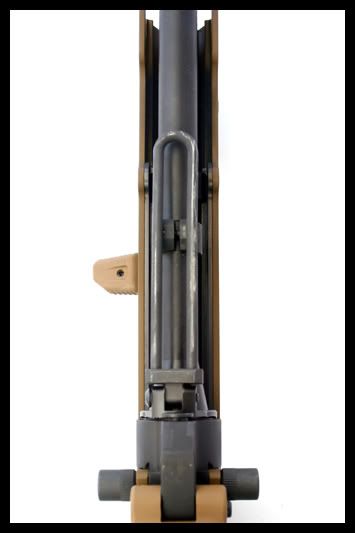
The barrel nut ratchet needed to be tightened a few clicks to the 6:30 position. The factory 6 o'clock position was not tight enough and resulted in poor accuracy. Due to the better long range performance, I re-zeroed with the 75gr then made another 10 shot group with the 55gr to check the point of impact difference. The 55gr impacted 2 MOA right of the 75gr, and the elevation was dead on. Also, the 10 shot groups of the 55gr shrunk to just over 2”. Now I moved on to the Larue targets at longer range. Remember, Larue targets are only 11” wide, so they present a much smaller target than full size 19” wide silhouettes (that are also proportionally taller). The 250 yard Larue targets were cake along with the 12” and 8” plates next to it. I moved on out to 500 yards and had my wife spot any misses for me. Surprisingly, I made a first round hit on the 500 yard Larue target. The ballistic calculations I had made beforehand indicated that the TA33's stadia lines after 200 yards would be about 25 yards short at each distance factoring in the 75gr bullets and the ACR's extra height over bore, so the hits I was making with a dead on 500 yard hold confused me at first. Finally, I remembered that the ACOG's stadia tree is calibrated for meters, so using it in yards instead just about canceled out the difference. After the first few hits, the wind picked up and fluctuated between calm and 5 mph full crosswind which can push a bullet laterally a foot at 500 yards. I chased the wind a bit and still kept up a good hit ratio on the Larue target with misses only left or right by mere inches according to my spotter. A full size silhouette would have given me nearly 100% hits. I loaded up some 55gr, and, correcting for the 2 MOA horizontal point of impact shift, was able to make hits on the 500 yard Larue target as well using the 500 meter stadia line (albeit not quite as often as the 75gr). For giggles I tried for the 750 yard Larue target, but since the TA33 stadia tree only goes 600 meters, I was holding well off into open space. After expending half a magazine to get 2 hits, I decided to stop wasting ammo and move on. Having done all of today's shooting from a fairly stable position using a front rest on the bench, I tried some 500 yard shots from prone unsupported resting off the magazine. While I did not experience any failures using the magazine as a monopod, the magazine did exhibit a lot of front to back play inside the magazine well. This created a very unstable platform and made hits much more difficult. My hit ratio dropped from 80% to about 20%. However, I was crammed between two concrete benches and did not have room for a solid prone position, so this may be less of an issue from a proper stance. When I was finished shooting, I removed the handguard and checked the barrel nut torque. The nut appeared to have loosened 1 click but was still tighter than when I started the day. I was not too concerned since the nut had just barely engaged that last click when I had tightened it, and it obviously did not have a problem hitting a 2 MOA target at 500 yards. Conclusions: The barrel nut needs to be tightened as much as possible or accuracy will suffer—factory tension may not be enough; the ACR's 1/9 barrel with stabilize 75gr bullets; the ACR is easily capable of hitting a man size target out to 500 yards. Total round count: 460 rounds. No malfunctions, lubrication, or cleaning to date. Further testing planned: accuracy evaluation using match ammo and precision scope; practical accuracy from field positions. <hr style="width: 100%; height: 2px;" /> **UPDATE** 7-22-11 Fourth Range Trip – 1 MOA I went to test some reloads in my Larue OBR 7.62 today, and the ACR accompanied me. Before shooting the OBR, I removed the US Optics SN-3 1.8-10x scope mounted in Larue OBR mount and replaced the ACOG TA33 with it on the ACR. The zero was very different from the OBR, so it took quite a few rounds to find paper. Once I did, I fired a 5 shot group of Hornady 75gr TAP which is the only match ammo that I had on hand. Using a machine rest, 10x scope, and match ammo, I was finally able to achieve a 1 MOA group with the ACR. 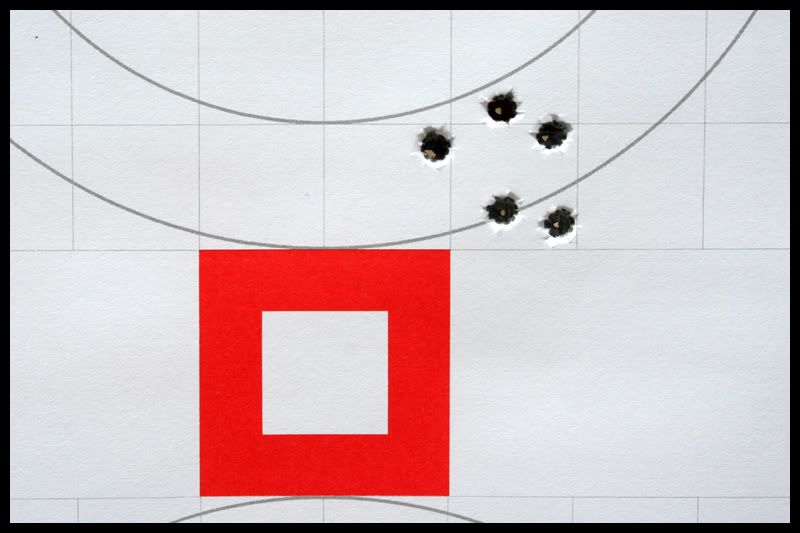
100 yard group using Hornady 75gr TAP. This group was fired from a machine rest using a US Optics SN-3 1.8-10x scope. At this point, I was dying to stretch the OBR's legs, so I replaced the USO with the TA33, verified the ACOG's zero was still on with a 10 shot group (it was), and moved on to shooting the OBR. The 10 shot group used to verify zero at 100 yards was 2" using Hornady 75gr Training ammo. I should note that the ACOG using a Larue mount retained a perfect zero verified with 10 shot groups at 100 yards after being removed from the ACR and replaced. Also, while moving the USO between rifles, I accidentally dropped it 4 feet onto the concrete floor. I remounted it, and it still fired within 1 MOA of zero at 100 yards. 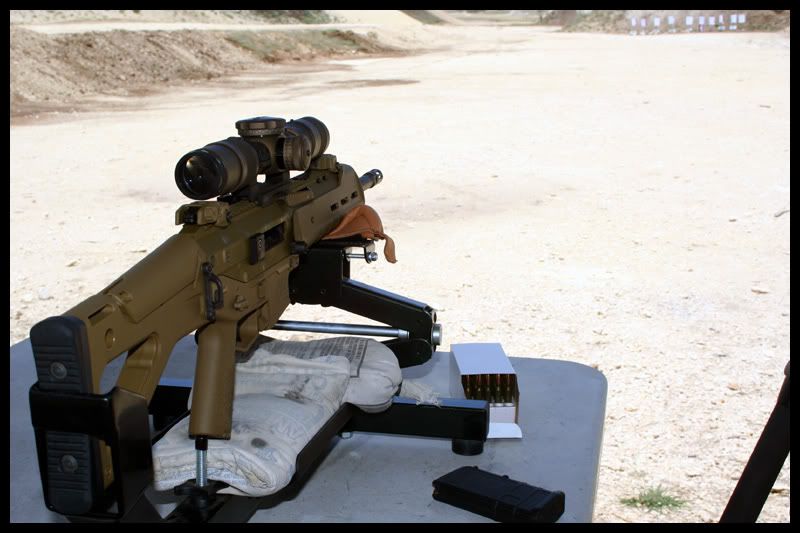
The ACR is mounted in the machine rest used for accuracy testing. The 100 yard targets are visible at the top right. Only 40 rounds were fired though the ACR today, but still no malfunctions. Since 75gr bullets are the top limit of a 1/9 twist barrel, I plan to retest the bench accuracy using some lighter weight match ammo. Conclusions: The ACR appears to be 1 MOA capable with match ammo. Total round count: 500 rounds. No malfunctions, lubrication, or cleaning to date. Further testing planned: accuracy evaluation using lighter weight match ammo. <hr style="width: 100%; height: 2px;" /> **UPDATE** 8-7-11 Fifth Range Trip – IDPA Carbine Match Today I competed in a local IDPA style carbine match with the ACR. Since all of the targets were within 25 yards, I removed the TA33 ACOG and used the stock Magpul sights. The round count was right around 100 rounds, and I used PMC X-Tac 55gr M193 5.56mm throughout the match. Again, no cleaning or lubrication was performed, and I did not experience any failures. As previously demonstrated, muzzle climb was minimal, and the recoil exhibited more of a side to side shake which made close in shooting almost like shooting a braked rifle. The ACR's weight and balance kept the muzzle fairly stable while shooting on the move—especially compared to the 6lbs AR I shot at the last IDPA style carbine match. That said I'm not a proponent of shooting while moving under most circumstances outside of close quarters room entry type tactics. This match provided a painful reminder of my first range trip: mechanical sight off set. I can normally negate the 2.5” sight off set of the AR15 outside of about 15 yards, but I definitely cannot with the ACR. At 15 yards, there was still a 3” off set between my point of aim and point of impact. This resulted in several clusters of shot groups just below the "A” zone for the first half of the match, but I finally figured it out near the end. Aiming for the neck provided a center chest hit at around 10 yards. Several emergency/slide lock reloads were performed during the match, and the ACR's bolt release made them much simpler for me since I shoot rifles left handed. Again, I use my support hand thumb to depress the bolt release instead of my strong hand trigger finger since the extra leverage makes it much easier.. Although the ACR offers an ambidextrous solution, I continued to push the magazine release with my support hand thumb to keep continuity with the AR platform. The rifle was kept in the shade when not in use, and I never experienced any heat buildup on the handguard during the 20 round (average) stages. Match video available here: http://www.youtube.com/watch?v=Pelvkx6GyZU Conclusions: Mechanical off set must still be accounted for at 15 yards, the ACR runs 5.56mm pressure ammo fine, the ACR bolt release offers beautiful relief for left handed shooters. Total round count: 600 rounds. No malfunctions, lubrication, or cleaning to date. Further testing planned: precise mechanical off set POA/POI mapping from 3 to 25 yards. <hr style="width: 100%; height: 2px;" /> **UPDATE** 8-17-11 Sixth Range Trip – Magazine Monopod Test I made a trip to the range today with some coworkers for some drills with our duty handguns and rifles. We shot mostly handgun with a little AR work, but I brought out my ACR when we finished for a quick test to see if it had any problems shooting prone off the magazine. The Texas Hill Country is currently under severe drought, so the already hard, rocky ground is devoid of any give or cushion to absorb impact. There is a quarter inch of sand/gravel on top, but it offers no impact protection from the hard surface underneath. This is as hard as the ground gets without moving to a stone/concrete surface. I was eager to test the magazine monopod issue since the ACR has gotten such a poor reputation for not functioning while resting on the magazine even though I have never heard any first hand accounts of this problem aside from Travis Haley's single comment on Facebook about an ACR malfunctioning once after dropping to prone. Since this comment caused such a stir, I decided to drop to prone and fire using the same method that he teaches. I have personally seen him demonstrate the technique at a Magpul Dynamics carbine course (great course by the way), and I watched that segment on the DVD before heading to the range just to be sure. I went a hair slower than Travis usually demonstrates since I was doing it five times in rapid succession and did not have any knee/elbow protection. However, I came down just hard with the magazine taking the brunt of the impact, so I do not believe that it was any less stressful on the weapon. I dropped to prone using the magazine to break my fall and fired four rounds using the magazine as a monopod then repeated for a total of five time. I did not experience any malfunctions and was using 5.56mm PMC X-Tac 55gr M193. Magazine monopod test video: http://www.youtube.com/watch?v=c2Hv-WBsYXI Conclusions: The ACR does not appear to be inherently incapable of using the magazine as support in the prone position. Total round count: 625 rounds. No malfunctions, lubrication, or cleaning to date. <hr style="width: 100%; height: 2px;" /> **UPDATE** 12-9-11 Accuracy Assessment Tried out some lighter weight match ammo from the bench today. I used the same setup as before: mechanical rest from the bench using a US Optics SN-3 1.8-10x on 10x magnification set to be parallax free at 100 yards. The ammunition used was Federal Gold Medal Match using 69 grain Sierra Match King BTHP bullets, and Federal Tactical TRU using 55 grain Sierra Gameking BTHP bullets. The ACR definitely preferred both loads to the heavier 75 grain Hornady training ammo. I fired two 10 shot groups of each load which is all I could afford at $10 per group. The ACR seemed to prefer the 69 grain FGMM with extreme spreads of 1.35” and 1.65” for an average of 1.50”, while both groups of the 55 grain TRU were exactly 2.00”. 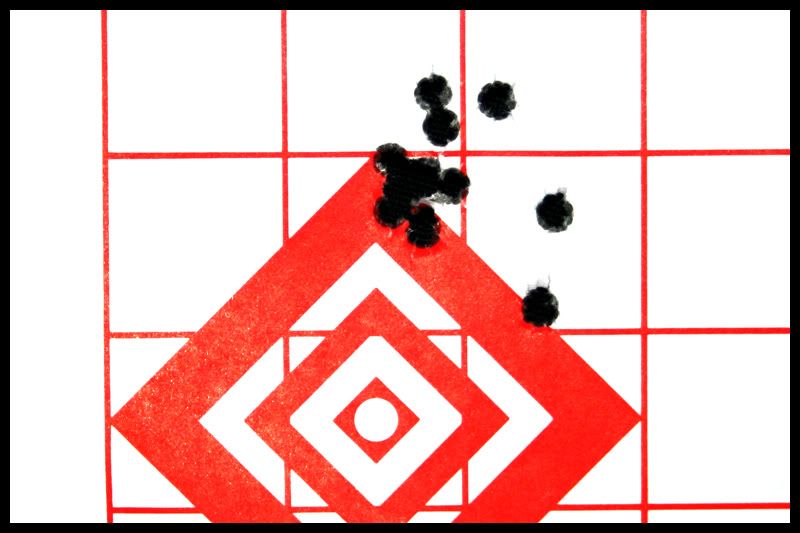
1.35" 10 shot group using Federal Gold Medal Match loaded 69 grain Sierra Match King BTHP bullets which proved to be the ACR's preferred load. Exhibiting the statistical validity of 10 shot groups to assess accuracy, the 5 shot cluster inside the larger group was under half an inch which would have been a dishonest accuracy assessment of the rifle. I consider inch and half 10 shot groups good accuracy for a service rifle, especially considering the 800 rounds worth of copper and carbon fouling that were not removed from the barrel before the evaluation. While 1 MOA precision is certainly desirable, non-dedicated precision rifles that exhibit consistently repeatable 1 MOA precision are rare in my experience. While lucky 5 shot groups are fairly common (there were 5 shot clusters under .5” using both loads), they do not offer enough consistency for an honest evaluation. Therefore, at $1 per shot, I did not waste any money them. Conclusions: The ACR offers good inherent accuracy for a service rifle. Rifle Class I took the ACR with me to a recent six day CSAT rifle instructor school, but I mostly used my work rifle (Noveske N4) since I was there for work to learn about teaching the AR platform. However, I did pull the ACR out briefly during some practice time to run drills and engage steel out 300 yards. I only put about 100 rounds through it which, along with some practice before the class, brings the total round count to 900 rounds with no malfunctions, lubrication, or cleaning to date. <hr style="width: 100%; height: 2px;" /> **UPDATE** 1-1-12 Suppressor Use I finally slapped on my Gem-Tech M4-96D suppressor (precursor to the current Gem-Tech G5) and swapped the gas regulator to the suppressed setting. Since I had already heated up the gas block from firing the rifle unsuppressed, I used the tip of a bullet through the regulator hole and the base of a second bullet to depress the regulator button which worked well. As a left handed rifle shooter using a squared up nose-to-charging-handle stance, I'm accustomed to a lot of gas in the face when shooting a suppressed semi-auto rifle. With an AR15, I have to close my right (outside) eye to prevent the gas venting out the ejection port directly into it even wearing eye protection. However, the ACR was a joy to shoot compared to an AR. While some gas still escapes from the ejection port, it just sort of lingers in the air instead of shooting straight into my eyes. While the gas was noticeable (it was right in front of my face) if I was thinking about, it was not at all bothersome, and I had not trouble shooting with both eyes open. I also lacked the carbon and lube that normally streak the right side of my face after shooting a suppressed AR. While a right handed shooter may not experience as large of a benefit, there was no charging handle at the rear of the rifle to vent gas leaving the left side of the rifle completely gas free. 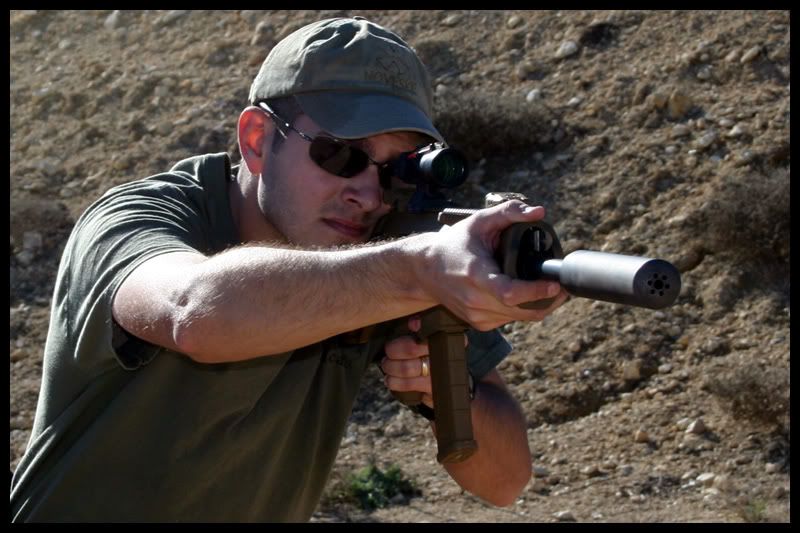
The selectable gas regulator reduced the amount of gas used to operate the piston in the "Suppressed" setting. As a left handed rifle shooter, this resulted in much less gas venting into my face. To this point, 900 rounds had only left a thin dusting of carbon inside the ACR's receiver and barrel lugs. However, 100 rounds suppressed finally made a visual impact leaving heavier carbon deposits caked in the chamber area. That said there have still been no failures at the 1000 round mark with no cleaning or lubrication. Field Positions As previously mentioned, I normally use an aggressive, squared up rifle stance with the stock low and close to my chest and support hand far out on the handguard for maximum recoil and muzzle control. However, when needed to take a precise shot and quick follow up shots are not required, I'll adopt a more traditional rifleman stance in the standing and kneeling positions. Likewise, when I need to use a high prone position that does not allow me to rest the magazine on the ground for support and again will not require quick follow up shots, I will adopt a more traditional prone position where the weight of the rifle is supported by bone structure. 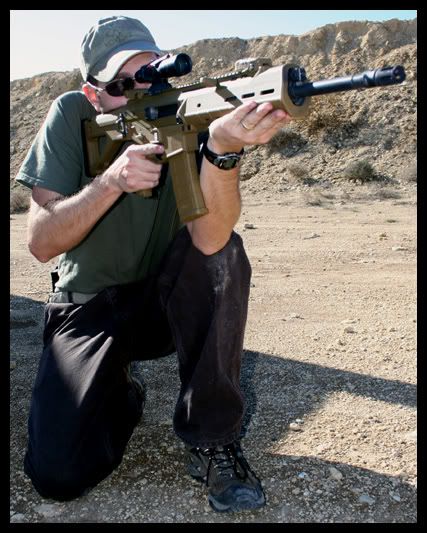
The ACR Basic's longer handguard allowed stable field positions. The rifle provided enough flexibility to allow a stable, balanced position even with the additional muzzle weight of a suppressor. The ACR's long fore end allowed me to get stable standing, kneeling, and prone positions making easy hits on 6” plates at 100 yards. The Basic's longer, plastic handguard was comfortable and provided a lot of flexibility, whereas the Enhanced's shorter, railed handguard would have likely been too short for my 6'2” frame to provide as stable of a position. Also, with the additional weight the suppressor added at the muzzle pulling the rifle's center of gravity even further forward, the Basic's longer handguard had enough space out front to still acquire a stable, balanced shooting position. <hr /> **UPDATE** 3-23-12 <span style="font-weight: bold; ">Quick Change Barrel POI Shift While debating whether to SBR the ACR and cut my original barrel, I ended up removing it completely from the receiver and back a few times. I am happy to report that the ACR exhibited minimal POI shift after reinstalling the barrel. Using 10-shot groups with Hornady 75gr ammo, the barrel exhibited an upward shift of just under 1 MOA after reinstalling the barrel. There was zero side-to-side POI shift. I torqued the barrel nut to what appeared to be the same position when reinstalling it, but a witness mark would be a good idea to be absolutely sure. |
|
|
|
Videos:
 acr_test_222  acr_test_el_prez  acr_test_triple_threat  acr_test_bill_drill  acr_test_max_hits Compilation video:  acr_test_close_range Magazine monopod test video:[url=http://www.youtube.com/watch?v=c2Hv-WBsYXI]  ACR_test_monopod |
|
|
|
Awesome write up! I also notice you have been to Tiger Valley. That place is great and I'm saving up to attend the level 2 carbine course.
|
|
|
|
Quoted:
Awesome write up! I also notice you have been to Tiger Valley. That place is great and I'm saving up to attend the level 2 carbine course. View Quote |
|
|
|
Quoted:
I thought this post was lost when the Bushmaster Industry forum was removed years ago, but somehow I stumbled across it today. Figured I'd repost for anyone that may be looking into the ACR now that it's starting to make a comeback. View Quote Nothing on the Internet is ever lost! Once it's on the internet, it's there for eternity. |
|
|
 Win a FREE Membership!
Win a FREE Membership!
Sign up for the ARFCOM weekly newsletter and be entered to win a free ARFCOM membership. One new winner* is announced every week!
You will receive an email every Friday morning featuring the latest chatter from the hottest topics, breaking news surrounding legislation, as well as exclusive deals only available to ARFCOM email subscribers.
AR15.COM is the world's largest firearm community and is a gathering place for firearm enthusiasts of all types.
From hunters and military members, to competition shooters and general firearm enthusiasts, we welcome anyone who values and respects the way of the firearm.
Subscribe to our monthly Newsletter to receive firearm news, product discounts from your favorite Industry Partners, and more.
Copyright © 1996-2024 AR15.COM LLC. All Rights Reserved.
Any use of this content without express written consent is prohibited.
AR15.Com reserves the right to overwrite or replace any affiliate, commercial, or monetizable links, posted by users, with our own.

